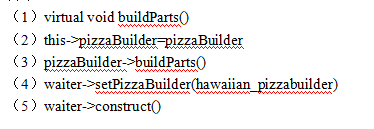阅读下列C函数和函数说明,将应填入(n)处的字句写在对应栏内。【说明】函数DeleteNode (Bitree *r, int e)的功能是:在树根结点指针为r的二叉查找(排序)树上删除键值为e的结点,若删除成功,则函数返回0,否则函数返回-1。二叉查找树结点的类型定义为:typedef struct Tnode{int data; /*结点的键值*/struct Tnode *Lchild, *Rchild; /*指向左、右子树的指针*/}*Bitree:在二叉查找树上删除一个结点时,要考虑3种情况:①
题目
阅读下列C函数和函数说明,将应填入(n)处的字句写在对应栏内。
【说明】
函数DeleteNode (Bitree *r, int e)的功能是:在树根结点指针为r的二叉查找(排序)树上删除键值为e的结点,若删除成功,则函数返回0,否则函数返回-1。二叉查找树结点的类型定义为:
typedef struct Tnode{
int data; /*结点的键值*/
struct Tnode *Lchild, *Rchild; /*指向左、右子树的指针*/
}*Bitree:
在二叉查找树上删除一个结点时,要考虑3种情况:
①若待删除的结点p是叶子结点,则直接删除该结点;
②若待删除的结点p只有一个子结点,则将这个子结点与待删除结点的父结点直接连接,然后删除结点p;
③若待删除的结点p有两个子结点,则在其左子树上,用中序遍历寻找关键值最大的结点s,用结点s的值代替结点p的值,然后删除结点s,结点s必属于上述①、②情况之一。
【函数】
int DeleteNode (Bitree *r,int e) {
Bitree p=*r,pp,s,c;
while ( (1) ){ /*从树根结点出发查找键值为e的结点*/
pp=p;
if(e<p->data) p=p->Lchild;
else p=p->Rchild;
}
if(!P) return-1; /*查找失败*/
if(p->Lchild && p->Rchild) {/*处理情况③*/
s=(2);pp=p
while (3) {pp=s;s=s->Rchild;}
p->data=s->data; p=s;
}
/*处理情况①、②*/
if ( (4) ) c=p->Lchild;
else c=p->Rchild;
if(p==*r) *r=c;
else if ( (5) ) pp->Lchild=c;
else pp->Rchild=c;
free (p);
return 0;
}
相似考题
更多“阅读下列C函数和函数说明,将应填入(n)处的字句写在对应栏内。【说明】 函数DeleteNode (Bitree *r, ”相关问题
-
第1题:
阅读以下函数说明和C语言函数,将应填入(n)处的字句写在答题纸的对应栏内。
【函数2.1说明】
递归函数sum(int a[], int n)的返回值是数组a[]的前n个元素之和。
【函数2.1】
int sum (int a[],int n)
{
if(n>0) return (1);
else (2);
}
【函数2.2说明】
有3个整数,设计函数compare(int a,int b,int c)求其中最大的数。
【函数2.2】
int compare (int a, int b, int c )
{ int temp, max;
(3) a:b;
(4) temp:c;
}
【函数2.3说明】
递归函数dec(int a[],int n)判断数组a[]的前n个元素是否是不递增的。不递增返回 1,否则返回0。
【函数2.3】
int dec( int a[], int n )
{
if(n<=1) return 1;
if(a[0]<a[1]) return 0;
return (5);
}
正确答案:(1)a[n-1]+sum(an-1)或者a[0]+sum(a+1n-1); (2)return 0; (3)temp=(a>b)? (4)max=(temp>c)? (5)dec(a+1n-1);
(1)a[n-1]+sum(a,n-1)或者a[0]+sum(a+1,n-1); (2)return 0; (3)temp=(a>b)? (4)max=(temp>c)? (5)dec(a+1,n-1); 解析:本题考查C语言函数和一些基本运算。
下面我们分别来分析这几个函数。在函数2.1中,题目要求用此递归函数求数组前 n个元素之和。递归函数的特点是在函数体中不停地调用函数本身,只是将其函数的参数范围改变。题目中要求我们求数组前n个元素之和,我们可以这样理解,即前n个元素之和等于第n个元素加上前n-1个元素之和,现在的问题转化成如何求前n-1个元素之和。同样的道理,可以将求前n-1个元素之和转化成求前n-2个元素之和,直到这个数小于0。从函数2.1的代码中可以知道,在计算以前,首先判断n与0的关系,如果n小于0,说明数组中无元素,因此,返回0值;如果n大于等于0,说明数组中有元素,应该返回的结果是第n个元素加上前n-1个元素之和,而前n-1个元素之和是调用函数本身来计算的。因此,第(1)空和第(2)空的答案分别是a[n-1)+sum(a,n-1),return()。
在函数2.2中,题目要求我们在三个数中取最大数,在数学中,我们从三个数中取最大数时,一般是首先拿其中两个数比较,取较大的数再与第三个数比较,再取其较大的数,这个数就是三个数中的最大数。从函数2.2的代码中知道,三个数a、b、c,两个整型变量temp与max。根据求三个数中最大数的数学过程和函数中已给出的代码可知,第(3)空处语句应该为temp=(a>b)?a:b,求得a、b中较大数并存放在变量temp中。第(4)空处语句为max=(temp>c)?temp:c。
在函数2.3中,题目要求判断数组a[]的前n个元素是否是不递增的。不递增返回1,否则返回0。要判断前n个元素是否是不递增的,需要判断前n-1个元素是否是不递增的,以及第n个元素与第n-1个元素的关系。此处与函数2.1一样,用的都是递归函数,只是出口不同,在函数2.1中,只要数组中没有元素了,递归结束,这里只要第n个元素大于第n-1个元素,则返回0,递归结束。又由if(a[0]a[1])语句可知,在每次调用函数时,都将其数组中的第一个元素与第二个元素比较来作为递归的出口,如果结果为假,就说明数组的前面两项的关系是不递增的,在下次调用中不用再考虑第一项。因此第(5)空应该是dec(a+1,n-1)。 -
第2题:
阅读以下函数说明和C语言函数,将应填入(n)处的字句写在对应栏内。
[说明]
已知r[1...n]是n个记录的递增有序表,用折半查找法查找关键字为k的记录。若查找失败,则输出“failure",函数返回值为0;否则输出“success”,函数返回值为该记录的序号值。
[C函数]
int binary search(struct recordtype r[],int n,keytype k)
{ intmid,low=1,hig=n;
while(low<=hig){
mid=(1);
if(k<r[mid].key) (2);
else if(k==r[mid].key){
printf("succesS\n");
(3);
}
else (4);
}
printf("failure\n");
(5);
}
正确答案:(1) (low+hig)/2 (2) hig=mid-1 (3) returnmid (4) low=mid+1 (5) return 0
(1) (low+hig)/2 (2) hig=mid-1 (3) returnmid (4) low=mid+1 (5) return 0 解析:折半查找法也就是二分法:初始查找区间的下界为1,上界为len,查找区间的中界为k=(下界+上界)/2。所以(1)应填“(low+hig)/2”。中界对应的元素与要查找的关键字比较。当kr[mid].key时,(2)填“hig=mid-1”;当k==r[mid].key时,(3)填“return mid”;当k>r[mid].key时,(4)填“low=mid+1”。如果low>hig时循环终止时,仍未找到需查找的关键字,那么根据题意返回0,即空(5)填“return 0”。 -
第3题:
()阅读下列说明和C语言程序,将应填入 (n)处的语句写在答题纸的对应栏内。[说明]下面程序是一个带参数的主函数,其功能是显示在命令行中输入的文本文件内容。[C语言函数]#include"stdio.h"main(argc,argv) int argc; char *argv[]; { (1) ; if((fp=fopen(argv[1],”r’’))== (2) ) { printf(”file not open!\n”);exit(0);} while( (3) ) putchar( (4) ); (5); }
正确答案:()
(1)FILE *fp; (2)NULL (3)!feof(fp) (4)fgetc(fp) (5)fclose(fp)
从程序功能来看,程序中需要用到文件型指针变量中,而主函数体没有定义,所以(1)应该填写的是“FILE *fp;”。接下来的语句是标准的打开只读文本文件的语句,显示的是文件没打开,说明文件名不存在,也就是为“NULL”。接着的while循环语句中有两处空白。前一个空白是控制循环的条件,从程序功能来看,要将文本文件中的所有字符显示出来,这儿当然只能填写“不是文件尾则继续循环”,具体说,需要填写的是“!feof(fp)”。(4)出现在循环体中的语句中,该循环体的功能是从fp指向的文本文件中读取单个字符并显示在屏幕上,此处使用的是putchar函数,该函数的功能是将形参对应的字符显示在屏幕上,所以该处的空白就是要显示的字符,这个字符必须是从文本文件中读取的单个字符,完成这项工作的可以利用fgetc()函数,所以(4)填写的是“fgetc(fp)”。最后一句应当是关闭文件,所以(5)应填fclose(fp)。
-
第4题:
阅读下列程序说明和C程序,将应填入(n)处的字句写在对应栏内。
[函数2.1说明]
下面程序的功能是计算x和y的最小公倍数。
[函数2.1]
main()
{ int m,n,d,r;
seanf("%d %d",&m,&n);
if(m<n) {r=m;m=n;n=r;}
(1);
while (d%n! =0) (2);
printf("%d\n",d);
}
[函数2.2说明]
下述程序接收键盘输入,直到句点“.”时结束。输入的字符被原样输出,但连续的空格输入将转换成一个空格。
[函数2.2]
include <stdio.h>
main()
{ char c,preChar='\0';
c = getchar();
while(c! = '.'){
if((3)) putchar(c);
else if(preChar! =' ') putchar(c);
(4);
c=(5);
}
}
正确答案:(1)d=m (2) d+=m或d=d+m (3) c!=‘’ (4) preChar=c (5) getchar()
(1)d=m (2) d+=m或d=d+m (3) c!=‘’ (4) preChar=c (5) getchar() 解析:(1)下文使用了变量d,因此需在此初始化,由下面循环的条件“d%n!=0”知初值不能是n,因此必为m;
(2)此处while循环生成最小公倍数d,其终止条件是n整除d,因此循环过程中需要保证m整除d并且d尽可能地小,于是d应以m为增量递增;
(3)当输入的字符非空格时,原样输出;
(4)程序中变量preChar用于记录上一次读入的字符,循环过程中应不断更新其值;
(5)接收下一个输入。 -
第5题:
试题三(共 15 分)
阅读以下说明和 C 程序,将应填入 (n) 处的字句写在答题纸的对应栏内。
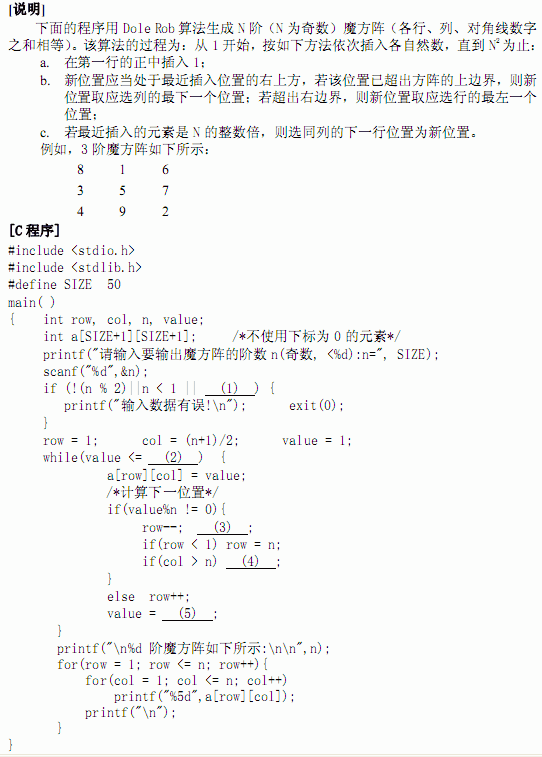 正确答案:
正确答案: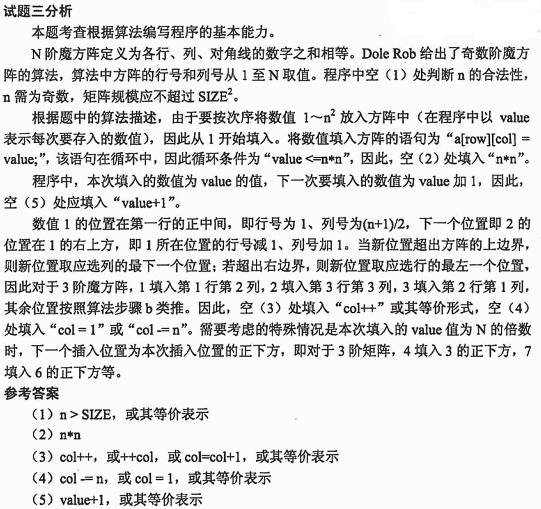
-
第6题:
阅读下列说明和?C++代码,将应填入(n)处的字句写在答题纸的对应栏内。
【说明】
阅读下列说明和?Java代码,将应填入?(n)?处的字句写在答题纸的对应栏内。
【说明】
某快餐厅主要制作并出售儿童套餐,一般包括主餐(各类比萨)、饮料和玩具,其餐品种
类可能不同,但其制作过程相同。前台服务员?(Waiter)?调度厨师制作套餐。现采用生成器?(Builder)?模式实现制作过程,得到如图?6-1?所示的类图。
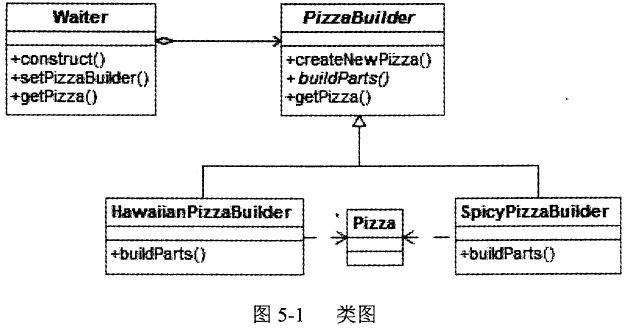
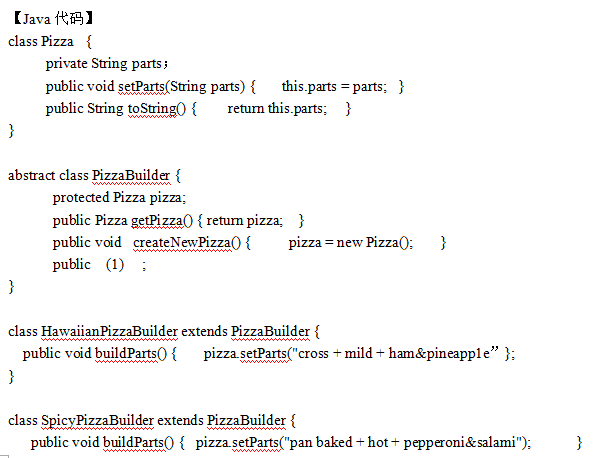
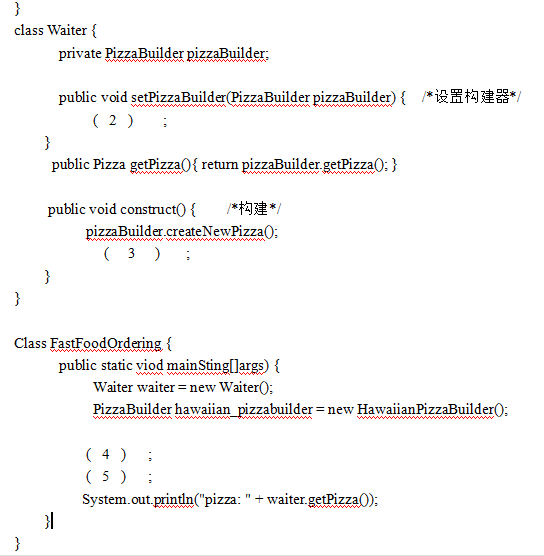
 答案:解析:
答案:解析: